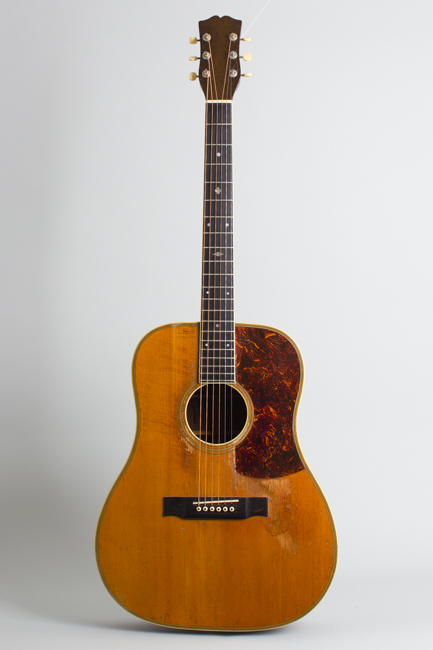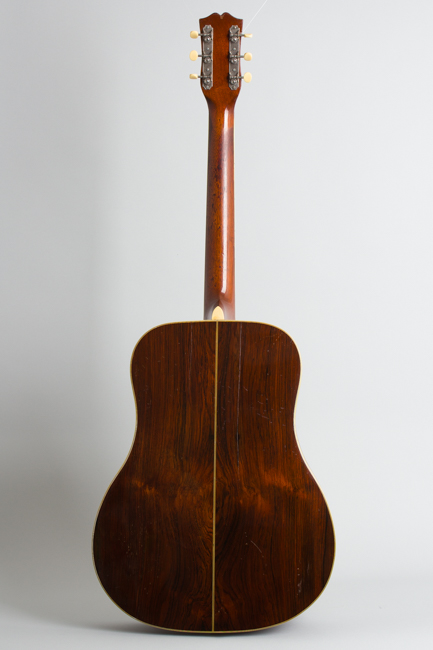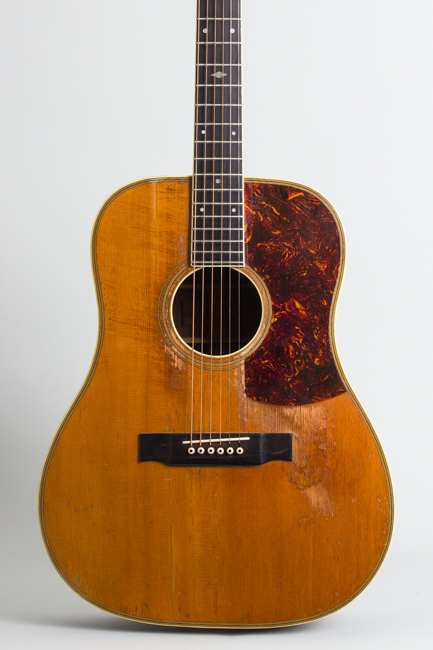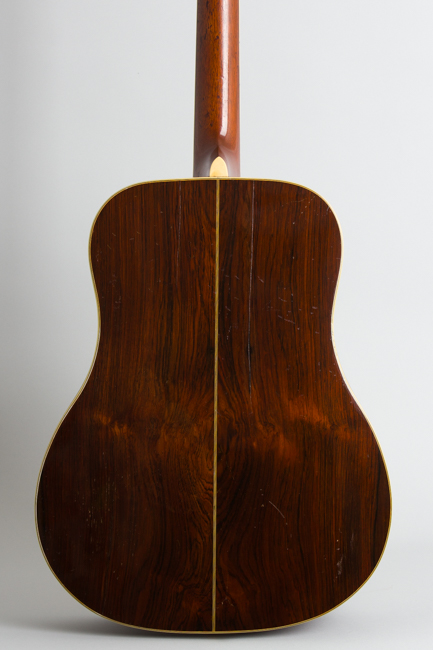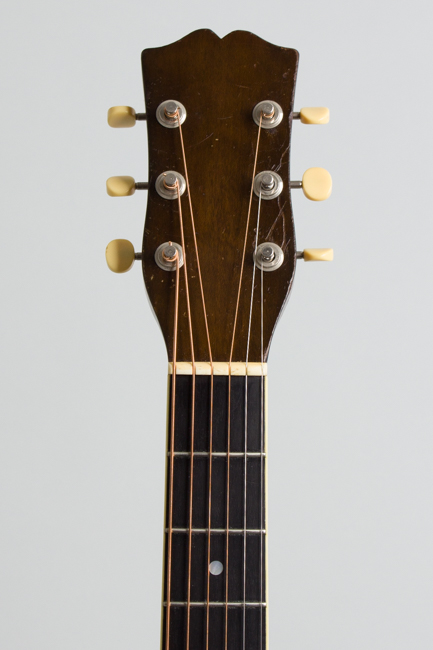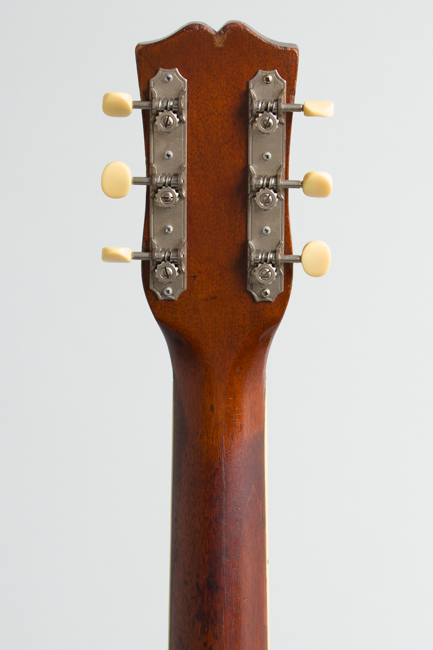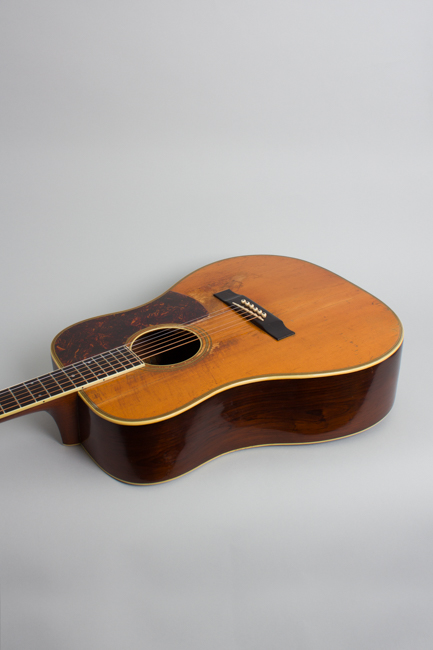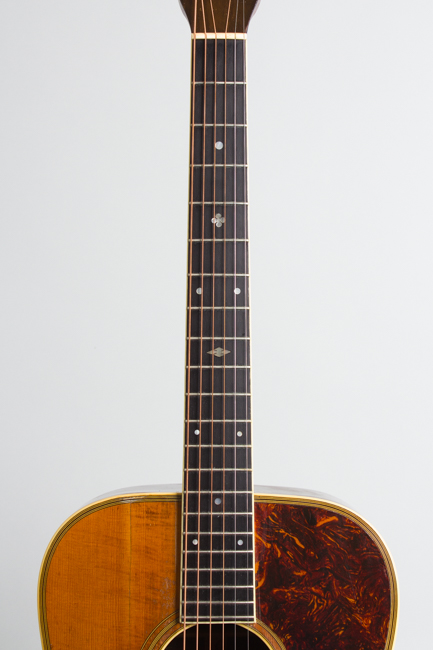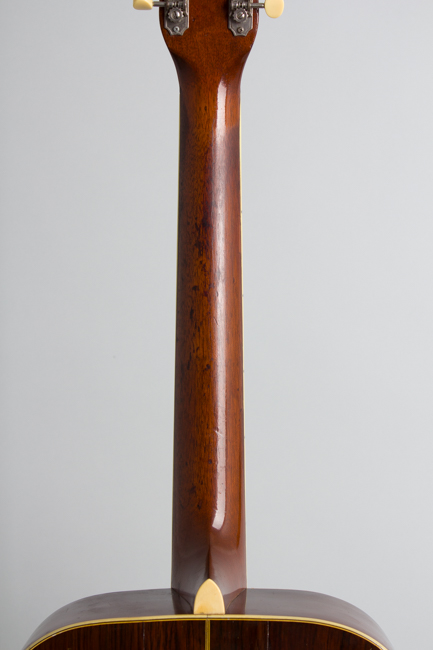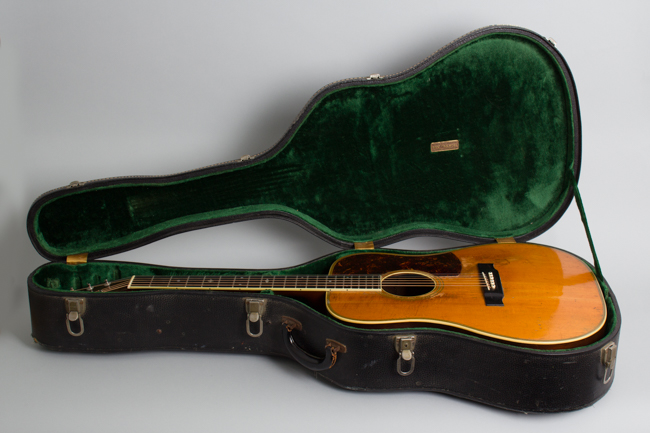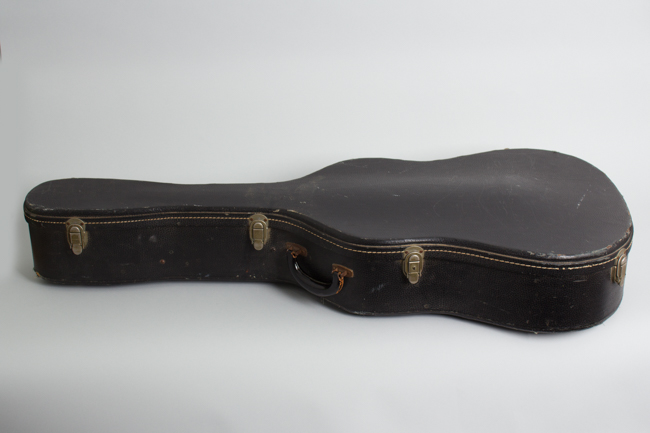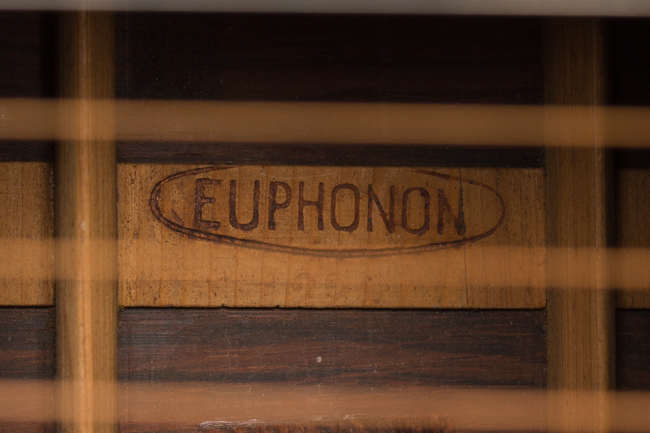Euphonon Dreadnought Acoustic Guitar, made by Larson Brothers (1938)
This item has been sold.
Item # 12129
Prices subject to change without notice.
Euphonon Dreadnought Model Acoustic Guitar, made by Larson Brothers (1938), made in Chicago, serial # 1228, natural lacquer finish, Brazilian rosewood back and sides, spruce top; mahogany neck with ebony fingerboard, period black hard shell case.
Any discussion of the finest flat-top guitars will eventually come around to the work of Carl and August Larson. From the very beginning of the 20th century up until WWII, the Larsons' small Chicago workshop turned out a dizzying assortment of handmade fretted instruments -- guitars, mandolins, the occasional ukulele, and even harp guitars. The catch is the brothers never put the name "Larson" on them.
This guitar carries a Euphonon stamp on the backstrip, the last of several trade names the Larsons used. August and Carl introduced this brand by the mid 1930s; most guitars so marked show "modern" features: a 14-fret neck joint, slimmer neck, solid, non-slotted peghead and often larger bodies. This well-worn Euphonon Dreadnought is one of the rarer Larson Brothers instruments of this period. All were strictly handmade, and in this era each one is unique. In the 1930s the brothers' shop at 536 Elm Street in Chicago functioned (in modern terms) as a custom shop, building one-offs mostly for direct sale. The brothers built whatever the customer desired, but even in the late 1930s their versions of Martin's wide-waisted design were relatively few.
The Larsons were at the time the only major individual builder specializing in the large, powerful flat-tops preferred by "Hillbilly" entertainers, including Martin-influenced Dreadnoughts like this one. This guitar shows the Larsons adapting Martin's influential design to their own style. The back and sides are the traditional Brazilian rosewood. The spruce top is constructed with the laminated X-bracing and subtly arched "built under tension" design the brothers developed 30 years before which proved ideally suited to large-bodied flat tops. The guitars of this period arguably show the structural and tonal advantages of August's innovations better than the smaller instruments of previous decades.
The top is multi-bound, with a large inlaid celluloid pickguard on the lower half of the face. The one-piece mahogany neck has a bound heavy ebony fingerboards inlaid with dots and a couple of trademark shaped pearl pieces; the headstock is plain. The neck is fairly wide (nearly 1 3/4" at the nut) but slim back-to-front with a surprisingly shallow profile. Larson neck shapes of this period were the customer's choice, so the feel can vary widely.
Larger body guitars with 14-fret necks are generally considered the cream of the Larson crop. With slimmer, more modern-feeling necks than the older 12-fret guitars, they are very comfortable to most players. The built-under-tension construction helps create a quick response and bright, ringing tone with strong sustain even in a large guitar. Many consider the 16" Euphonons the finest-sounding of all Larson instruments; indeed, some of the best steel-string guitars ever made.
This unusual pre-war Dreadnought is certainly a contender, somewhat brighter and tighter sounding than a typical late-30s Martin D-28 but certainly a contender and a fantastic survivor from the golden age of "Hillbilly" radio and the guitars that powered it!
Overall length is 41 in. (104.1 cm.), 15 3/4 in. (40 cm.) wide at lower bout, and 4 3/4 in. (12.1 cm.) deep. Scale length is 25 1/2 in. (648 mm.). Width of nut is 1 23/32 in. (44 mm.).
This guitar is a real survivor of "the Golden Age of Hillbilly Music", showing a lot of repair and repair but still an excellent playing and sounding instrument, a real piece of history. There is general wear overall with heavy pickwear to the top with some ancient topical touch-up overfinish over the heaviest spots. The top finish remains largely original with some sections over various repairs polished out but no wholesale overspray. Several sections of the back show some finish work as well, with areas over several crack repairs polished out and a section of the lower center redone for no obvious reason. The finish on the sides and neck appears more fully original, with some odd lacquer spots on the back of the headstock rear and some heavy scratching on its face.
There are a number of mostly older repairs, as is typical of these instruments often heavily used by professional radio entertainers. The original small bridge has been replaced by a somewhat oversize bridge with an extended rear flange and slightly scalloped wings. Beneath this the pin holes were plugged and redrilled in the original small maple bridgeplate. There are also a couple of small screw holes in the ends of the bridgeplate where someone must have added Gibson-style bolts to the wings of an older bridge long ago. The rest of the interior including the unique laminated bracing remains original, with some minor regluing.
The top shows three repaired spruce grain splits behind the bridge, sealed but visible with a couple of small cleats added beneath. There is also a spruce grain split running back from forward edge to the area above soundhole, repaired with no cleats but more visible polish-out to the finish. There are a couple of sealed grain splits under the fingerboard extension.
The back has two grain splits to the rosewood above and below the neck block, well sealed with a couple of larger cleats installed visible through the soundhole. There is also one grain split on lower back, sealed but not cleated. As noted the back has some overfinishing related to these repairs.
There is a repaired tight grain split in the back of neck from the first to fourth fret area; this is solidly sealed but slightly feelable; the s=finish is worn through in this area and no overfinish was added on this repair. The headstock is fitted with period Kluson openback tuners, but oversize bushings on headstock and some odd glue smears around the strips indicate another previous tuner installation.
The neck has been reset neatly, refretted and fingerboard rebound in the correct style. Playability is excellent, and while the litany of repair may sound daunting this is simply a superb and extremely rare guitar, seldom seen in any condition. It has a sound all its own, less bass-heavy than the typical Martin D-28 with more sing in the high end and exceptional sustain. It resides in an old Martin Dreadnought case from just a bit later with two "Fife & Nichols" badges inside, indicating it has some Hollywood history behind it. Overall Very Good Condition.
Any discussion of the finest flat-top guitars will eventually come around to the work of Carl and August Larson. From the very beginning of the 20th century up until WWII, the Larsons' small Chicago workshop turned out a dizzying assortment of handmade fretted instruments -- guitars, mandolins, the occasional ukulele, and even harp guitars. The catch is the brothers never put the name "Larson" on them.
This guitar carries a Euphonon stamp on the backstrip, the last of several trade names the Larsons used. August and Carl introduced this brand by the mid 1930s; most guitars so marked show "modern" features: a 14-fret neck joint, slimmer neck, solid, non-slotted peghead and often larger bodies. This well-worn Euphonon Dreadnought is one of the rarer Larson Brothers instruments of this period. All were strictly handmade, and in this era each one is unique. In the 1930s the brothers' shop at 536 Elm Street in Chicago functioned (in modern terms) as a custom shop, building one-offs mostly for direct sale. The brothers built whatever the customer desired, but even in the late 1930s their versions of Martin's wide-waisted design were relatively few.
The Larsons were at the time the only major individual builder specializing in the large, powerful flat-tops preferred by "Hillbilly" entertainers, including Martin-influenced Dreadnoughts like this one. This guitar shows the Larsons adapting Martin's influential design to their own style. The back and sides are the traditional Brazilian rosewood. The spruce top is constructed with the laminated X-bracing and subtly arched "built under tension" design the brothers developed 30 years before which proved ideally suited to large-bodied flat tops. The guitars of this period arguably show the structural and tonal advantages of August's innovations better than the smaller instruments of previous decades.
The top is multi-bound, with a large inlaid celluloid pickguard on the lower half of the face. The one-piece mahogany neck has a bound heavy ebony fingerboards inlaid with dots and a couple of trademark shaped pearl pieces; the headstock is plain. The neck is fairly wide (nearly 1 3/4" at the nut) but slim back-to-front with a surprisingly shallow profile. Larson neck shapes of this period were the customer's choice, so the feel can vary widely.
Larger body guitars with 14-fret necks are generally considered the cream of the Larson crop. With slimmer, more modern-feeling necks than the older 12-fret guitars, they are very comfortable to most players. The built-under-tension construction helps create a quick response and bright, ringing tone with strong sustain even in a large guitar. Many consider the 16" Euphonons the finest-sounding of all Larson instruments; indeed, some of the best steel-string guitars ever made.
This unusual pre-war Dreadnought is certainly a contender, somewhat brighter and tighter sounding than a typical late-30s Martin D-28 but certainly a contender and a fantastic survivor from the golden age of "Hillbilly" radio and the guitars that powered it!
Overall length is 41 in. (104.1 cm.), 15 3/4 in. (40 cm.) wide at lower bout, and 4 3/4 in. (12.1 cm.) deep. Scale length is 25 1/2 in. (648 mm.). Width of nut is 1 23/32 in. (44 mm.).
This guitar is a real survivor of "the Golden Age of Hillbilly Music", showing a lot of repair and repair but still an excellent playing and sounding instrument, a real piece of history. There is general wear overall with heavy pickwear to the top with some ancient topical touch-up overfinish over the heaviest spots. The top finish remains largely original with some sections over various repairs polished out but no wholesale overspray. Several sections of the back show some finish work as well, with areas over several crack repairs polished out and a section of the lower center redone for no obvious reason. The finish on the sides and neck appears more fully original, with some odd lacquer spots on the back of the headstock rear and some heavy scratching on its face.
There are a number of mostly older repairs, as is typical of these instruments often heavily used by professional radio entertainers. The original small bridge has been replaced by a somewhat oversize bridge with an extended rear flange and slightly scalloped wings. Beneath this the pin holes were plugged and redrilled in the original small maple bridgeplate. There are also a couple of small screw holes in the ends of the bridgeplate where someone must have added Gibson-style bolts to the wings of an older bridge long ago. The rest of the interior including the unique laminated bracing remains original, with some minor regluing.
The top shows three repaired spruce grain splits behind the bridge, sealed but visible with a couple of small cleats added beneath. There is also a spruce grain split running back from forward edge to the area above soundhole, repaired with no cleats but more visible polish-out to the finish. There are a couple of sealed grain splits under the fingerboard extension.
The back has two grain splits to the rosewood above and below the neck block, well sealed with a couple of larger cleats installed visible through the soundhole. There is also one grain split on lower back, sealed but not cleated. As noted the back has some overfinishing related to these repairs.
There is a repaired tight grain split in the back of neck from the first to fourth fret area; this is solidly sealed but slightly feelable; the s=finish is worn through in this area and no overfinish was added on this repair. The headstock is fitted with period Kluson openback tuners, but oversize bushings on headstock and some odd glue smears around the strips indicate another previous tuner installation.
The neck has been reset neatly, refretted and fingerboard rebound in the correct style. Playability is excellent, and while the litany of repair may sound daunting this is simply a superb and extremely rare guitar, seldom seen in any condition. It has a sound all its own, less bass-heavy than the typical Martin D-28 with more sing in the high end and exceptional sustain. It resides in an old Martin Dreadnought case from just a bit later with two "Fife & Nichols" badges inside, indicating it has some Hollywood history behind it. Overall Very Good Condition.
